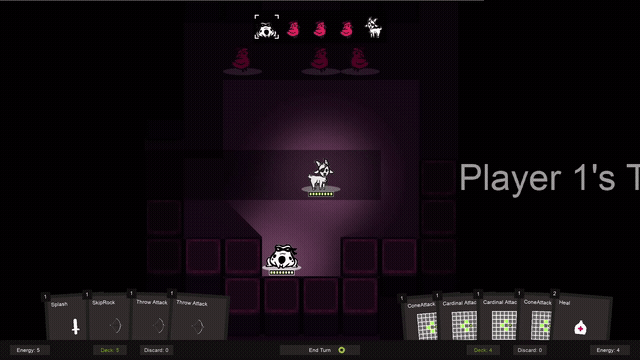Let There Being Lighting!
Preface
Since my initial portfolio listing, the game has evolved significantly, so I decided to start sharing blog-style updates. While I don’t plan to maintain a regular posting schedule, I will publish updates whenever the game undergoes meaningful changes.
Let There be Lighting!
Probably the most immediately noticeable change since the first post is the implementation of 2D lighting and Fog of War!
As players move around the encounter grid, their light source reveals tiles hidden in the shadows. Treasures and enemies may be lurking in these shadows; if they are outside a player’s light radius, they won’t be added to the turn order array. I introduced this “edge of the shadows” feature to let players explore more safely and decide whether to engage enemies—essentially serving as a “perception check.”
The image below shows both players within the lit tiles, while the enemy birds remain in the unlit, shaded tiles. Since the enemy birds aren’t illuminated, they haven’t been added to the turn order yet, giving players the chance to plan how they want to approach or avoid the situation.
This next image shows the Goat player moving closer to the birds, lighting up the tiles they occupy and adding them to the turn order. As players explore the level, the opaque shaded tiles gradually become illuminated, revealing the surrounding area.
I don’t see this mechanic as necessary for every encounter, so I designed the system to allow encounters to start with varying amounts of lit or shaded tiles, depending on the level design goals.
One key reason for adding this mechanic is to encourage players to stick together. In many co-op games, being separated from your partner can be frustrating—it can disrupt the camera, make it easier to get flanked, and more. Instead of punishing players for splitting up, I incentivize them to stay close by granting the current player extra energy if they start their turn within the light radius of their co-op partner.
A quick player feedback note worth mentioning: during playtesting, I found that players often ended up in empty rooms after defeating all enemies, then had to spend several turns using all their energy to leave and explore elsewhere. One tester suggested reducing the movement energy cost to zero within unshaded tiles when no enemies are nearby.
I quite like this idea, and it immediately improved the experience for at least one player, allowing them to get back into the action faster. However, the results have been mixed—one player can explore and encounter new challenges right away, while the other spends several turns catching up. This doesn’t feel very co-op friendly, but I’m currently unsure how to address it. For now, I’m leaving the mechanic as is, gathering more player feedback, and plan to revisit this issue later with fresh ideas on how to improve it.
Prototype Art Update!
Another noticeable visual change is the addition of cute little pirate animals as units! The assets were created by Kylie O’Keefe, with the animations coded by yours truly.





The current creative theme I’m exploring is a Peter Pan–style fantasy pirate setting, featuring cute little animals like these as characters. Everything is still a work in progress and subject to change, so don’t get too attached!
Change In Design Direction
Since the initial post, I’ve received a lot of feedback on the concept and done considerable thinking about CardsGrid’s design direction. Because I’m aiming for a fun co-op experience where a “campaign” could span a weekend for two players, it doesn’t make sense to include roguelike elements. I don’t want encounter failure to be an end state. Much like in D&D, I want players to create their own unique stories they can share with others. I’m encouraging a “roll with the punches” mindset and leaning away from roguelike deck-builder design, instead doubling down on old-school party-based RPG design—where character and deck progression can be a longer, more engaging journey. Below are my new high-level design slides capturing this idea.


Looking Ahead
The next big focus for me is designing encounters that challenge players and prompt them to consider specific questions, such as:
Does the group have enough… Damage or Healing or Movement?
Does the group know how to protect and help each other?
As I build these encounters, I want to ensure the workflow is smooth, efficient, and easily adjustable. I anticipate creating hundreds of encounters that vary depending on the group’s stats and progress throughout the campaign. With my next goal being the ability to load multiple encounters in a single play session while carrying player progression between them, I’ve mapped out the upcoming tasks below.





